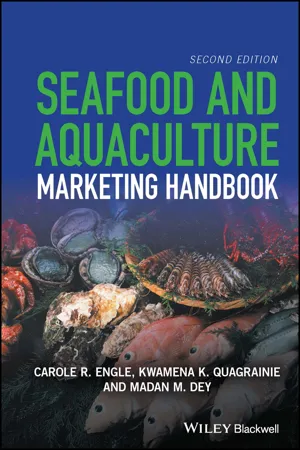
Seafood and Aquaculture Marketing Handbook
- English
- ePUB (mobile friendly)
- Available on iOS & Android
Seafood and Aquaculture Marketing Handbook
About this book
Aquaculture, the farming of aquatic animals and plants, and other seafood business continue to grow rapidly around the world. However, many of these businesses fail due to the lack of sufficient attention to marketing. The Seafood and Aquaculture Marketing Handbook provides the reader with a comprehensive yet user-friendly presentation of key concepts and tools necessary for aquaculture and seafood businesses to evaluate and adapt to changing market conditions.
Markets for aquaculture and seafood products are diverse, dynamic, and complex. The Seafood and Aquaculture Marketing Handbook presents fundamental principles of marketing with specific discussion of aquaculture and seafood market channels and supply chains from around the world, and builds towards a step-by-step approach to strategic market planning for successful aquaculture and seafood businesses.
This book is an essential reference for all aquaculture seafood business as well as students of aquaculture. The volume contains a series of synopses of specific markets, an extensive annotated bibliography, and webliography for additional sources of information.
Written by authors with vast experience in international marketing for aquaculture and seafood products, this volume is a valuable source of guidance for those seeking to identify profitable markets for their aquaculture and seafood products.
Frequently asked questions
- Essential is ideal for learners and professionals who enjoy exploring a wide range of subjects. Access the Essential Library with 800,000+ trusted titles and best-sellers across business, personal growth, and the humanities. Includes unlimited reading time and Standard Read Aloud voice.
- Complete: Perfect for advanced learners and researchers needing full, unrestricted access. Unlock 1.4M+ books across hundreds of subjects, including academic and specialized titles. The Complete Plan also includes advanced features like Premium Read Aloud and Research Assistant.
Please note we cannot support devices running on iOS 13 and Android 7 or earlier. Learn more about using the app.
Information
Chapter 1
Seafood and aquaculture markets
Global trends in seafood and aquaculture markets
| Area | Domesticated | Earliest attested date of domestication | |
| Plants | Animals | ||
| Independent origins of domestication | |||
| Southwest Asia | Wheat, pea, olive | Sheep, goat | 8500 B.C. |
| China | Rice, millet | Pig, silkworm | By 7500 B.C. |
| Mesoamerica | Corn, beans, squash | Turkey | By 3500 B.C. |
| Andes and Amazonia | Potato, manioc | Llama, guinea pig | By 3500 B.C. |
| Eastern U.S. | Sunflower, goosefoot | None | 2500 B.C. |
| Sahel | Sorghum, African rice | Guinea fowl | By 5000 B.C. |
| Tropical West Africa | African yams, oil palm | None | By 3000 B.C. |
| Ethiopia | Coffee, tea | None | Unknown |
| New Guinea | Sugar cane, banana | None | 7000 B.C. |
| Local demonstration following arrival of founder crops from elsewhere | |||
| Western Europe | Poppy, oat | None | 6000–3500 B.C. |
| Indus Valley | Sesame, eggplant | Humped cattle | 7000 B.C. |
| Egypt | Sycamore fig, chufa | Donkey, cat | 6000 B.C. |

Table of contents
- Cover
- Title Page
- Table of Contents
- About the authors
- Chapter 1: Seafood and aquaculture markets
- Chapter 2: Demand and supply: basic economic premises
- Chapter 3: Seafood and aquaculture marketing concepts
- Chapter 4: Market trends
- Chapter 5: Seafood market channels
- Chapter 6: Seafood and aquaculture product processing
- Chapter 7: The international market for seafood and aquaculture products
- Chapter 8: Marketing by aquaculture growers
- Chapter 9: Marketing strategies and planning for successful aquaculture businesses
- Chapter 10: Marketing research methodologies
- Chapter 11: Seafood demand analysis
- Chapter 12: Policies and regulations governing seafood and aquaculture marketing
- Glossary
- Annotated bibliography of aquaculture marketing information sources
- Annotated webliography of sources of data and information for aquaculture marketing
- Index
- End User License Agreement